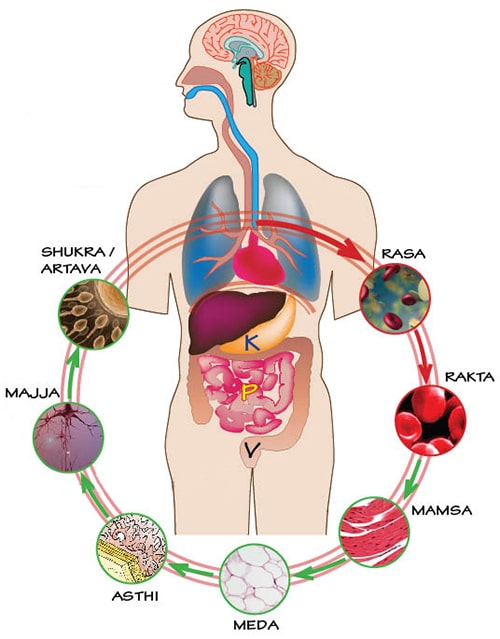
What is Dhatus?
Dhatus refers to the seven fundamental tissues that constitute the human body. Derived from the Sanskrit word “Dhātu,” meaning “that which holds,” Dhatus represent the building blocks of our physical structure and are responsible for maintaining the overall health and functioning of the body. There are seven of these Dhatus and in Ayurveda, they are called Sapta Dhatus – Rasa, Rakta, Mamsa, Meda, Asthi, Majja, and Sukhra. Let’s look at these Dhatus one by one.
1. Rasa Dhatus
The primary function of Rasa Dhatu is to provide nourishment to all the cells, tissues, and organs in the body. You can say that Kapha is the main player in this Dhatu. It is primarily made up of water. According to Ayurveda, the qualities of Rasa Dhatu are primarily influenced by the diet and lifestyle choices we make. When Rasa Dhatu is insufficient or of poor quality, it may manifest as symptoms like fatigue, weakness, poor immunity, dryness, and lack of nourishment. On the other hand, excessive accumulation or vitiation of Rasa Dhatu can contribute to conditions like water retention, congestion, excessive mucus production, and impaired metabolism.
2. Rakta Dhatu
The term “Rakta” translates to “red” and signifies the characteristic colour of blood. Pitta plays a major role in this Dhatu. When Rakta Dhatu is deficient or of poor quality, it may manifest as symptoms like anaemia, fatigue, pale complexion, poor circulation, and weakened immune function. Excessive accumulation or vitiation of Rakta Dhatus can contribute to conditions such as inflammation, bleeding disorders, skin disorders, and various blood-related diseases. As Rakta Dhatu is related to Pitta when it is excess the heat increases in the body and when the Dhatu depletes the heat also decreases in the body.
3. Mamsa Dhatu
Mamsa Dhatu is derived from the Sanskrit word ‘Mamsa,’ which translates to flesh or muscle tissue. It can be related to Earth and Fire elements. According to Ayurveda, Mamsa Dhatu represents the muscular layer of the body and is responsible for providing structure, stability, and movement. It is nourished by Rakta Dhatu. It acts as a supportive framework, enabling locomotion and facilitating the functioning of various bodily systems. Imbalances in this tissue can lead to various muscular disorders and diseases. It is important to consume food related to earth elements to maintain the muscles.
4. Medas Dhatu
The term “Meda” translates to “fat” and represents the storage and utilization of energy in the body. It refers to the adipose tissue or fat tissue in our bodies. Meda Dhatu acts as a cushioning layer around organs, protecting them from impact or injury. It helps in lubrication, regulates body temperature, and prevents heat loss. In Medas Dhatu, water is the primary element and earth is the secondary element. It is nourished by Mamsa Dhatu. When Meda Dhatu is excessive or of poor quality, it may manifest as obesity, excess weight gain, high cholesterol levels, metabolic disorders, and cardiovascular diseases. Insufficient or impaired Meda Dhatu can lead to issues like dry skin, brittle hair, hormone imbalances, and difficulty in maintaining a healthy body weight.
5. Asthi Dhatu
The term “Asti” translates to “bone,” and it represents the solid framework upon which our body is built. It is interesting that hair and nails are the waste products (malas) of the formation of Asthi Dhatu. It is nourished by Medas Dhatu.
Consuming a well-balanced diet that includes a sufficient amount of earth and air is essential for promoting the production of a healthy Asthi Dhatu. Psychologically, Asthi Dhatu empowers individuals to assert themselves in the world. A person’s decisiveness and confidence are enhanced by a healthy and balanced Asthi Dhatu. The insufficiency of Asthi Dhatu can result in various health issues such as hair loss, brittle nails, discomfort in the joints, osteoporosis, and dental problems.
6. Majja Dhatu
In Ayurveda, an ancient Indian system of medicine, Majja Dhatu refers to the bone marrow and nervous tissue in our bodies. Majja Dhatu occupies the vacant spaces within the bones, brain cavity, spine, and nerve channels, providing them with necessary support and structure. It is nourished by Asthi Dhatu. Psychologically, Majja Dhatu contributes to our sense of fulfilment by filling the inner void that we may encounter. Therefore when this Majja Dhatu depletes you can imagine the psychological effect it may have on you.
7. Shukra Dhatu
The term “Shukra” translates to “pure” or “bright”. Shukra Dhatu refers to the reproductive tissue or semen in men and the reproductive tissue in women. Sukhra is considered the essence of the Dhatus & it holds responsibility for life, vitality, and energy. In the cycle of Dhatu transformation, shukra marks the final stage and it is considered to be the most refined one. Imbalances or disturbances in Shukra Dhatu can lead to various reproductive and sexual health issues. Psychologically, Shukra Dhatu plays a significant role in sustaining creativity. A healthy shukra Dhatu nurtures a natural creative instinct and enables the realization of creative endeavours from start to finish.
Click here to hear more interesting Holistic Ayurveda Rejuvenation Story
Finally, we are reminded of the tremendous connections that exist among our bodies, the natural world, and the cosmos. According to what Ayurveda teaches, we may create a harmonious state of well-being that is in step with the rhythms of life by comprehending and nourishing our Dhatus. Within the depths of Ayurveda lies the key to unlocking the extraordinary potential of your body, mind, and spirit.
At Sri Sri Ayurveda Hospital, we also offer online consultation support with our Ayurveda specialists to get the right guidance from the comfort of your home. Connect to our specialists and plan an individual path back to health.

